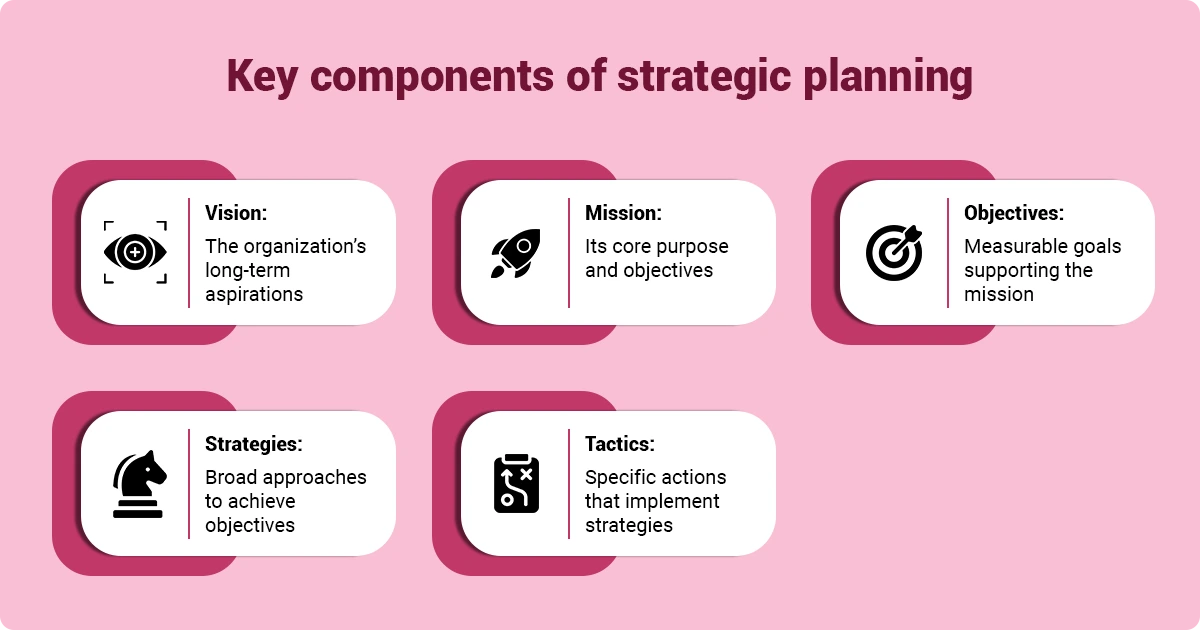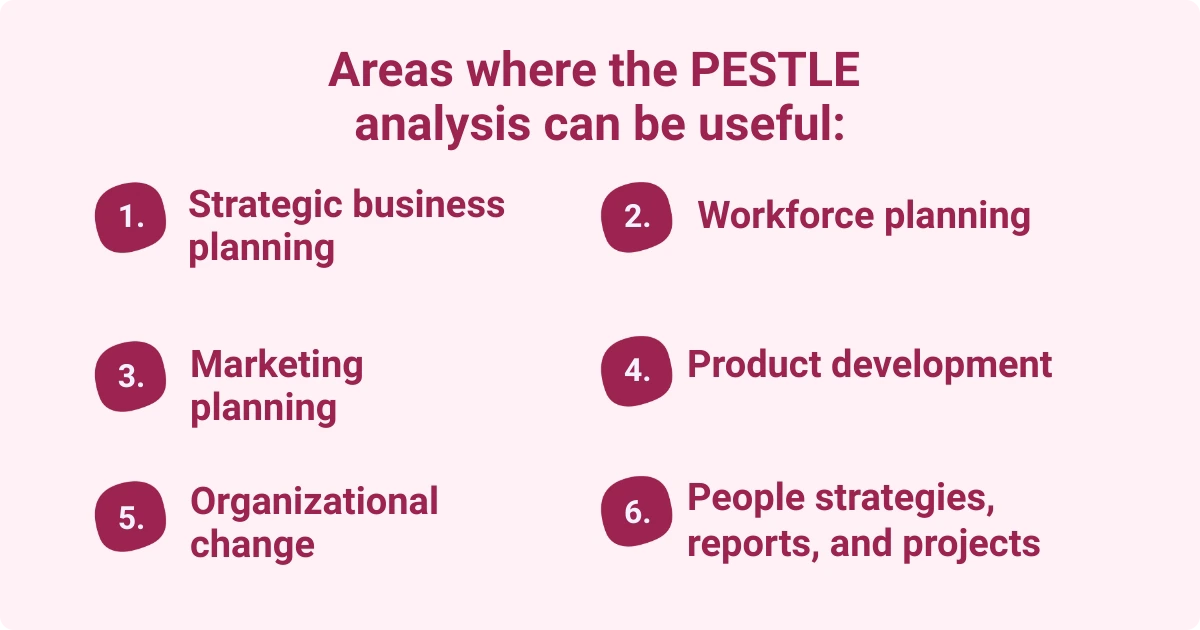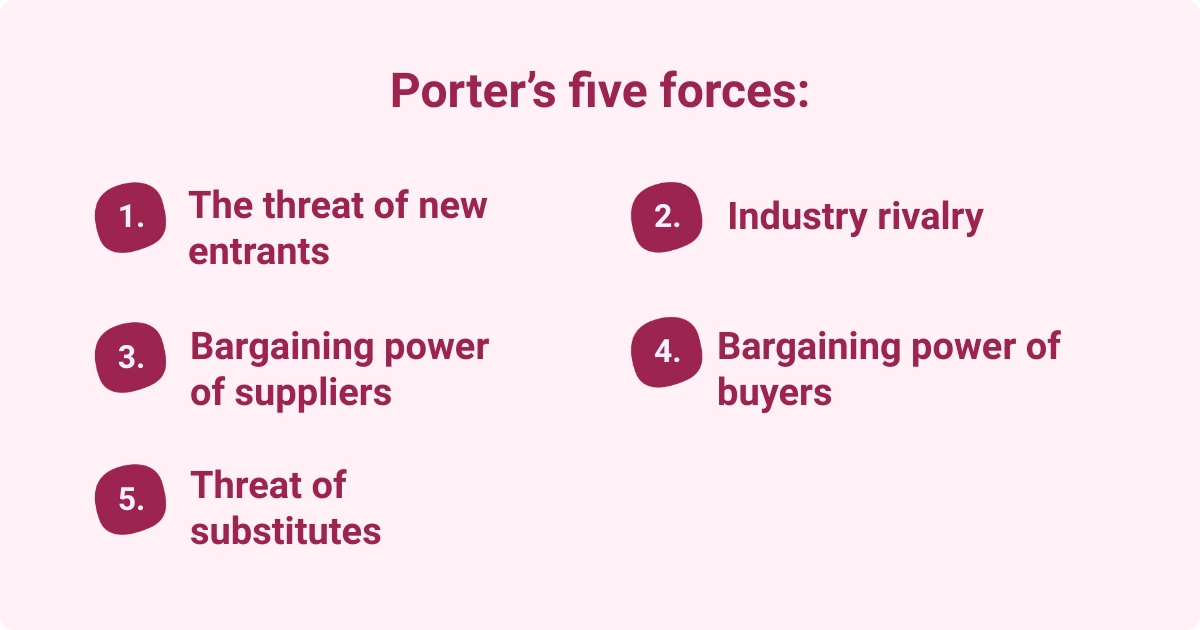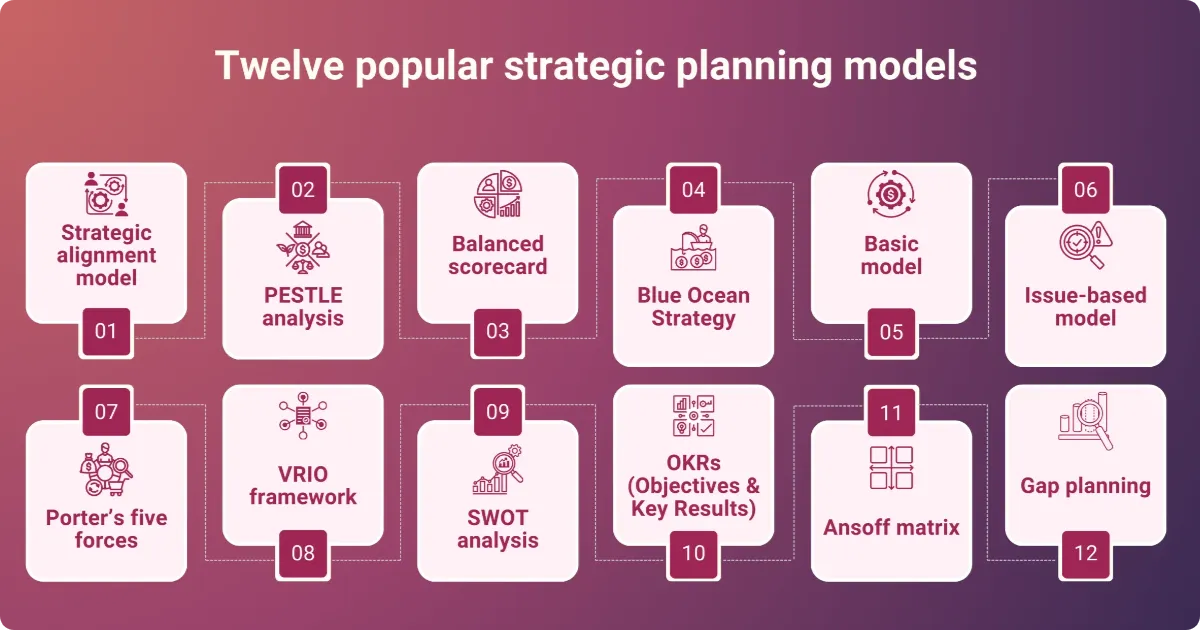Strategic Planning Models: Unveiling Effective Business Strategies for Success

As your business grows and evolves, it’s important to have strategies in place to support your long-term vision. Implementing the right strategic planning models is essential for sustainable success while creating an engaged workforce aligned with the company’s mission.
Recent research from Gallup and Workhuman® shows that factors like employee recognition can reduce turnover by as much as 45%. Creating intentional structures across every area of your business, from culture to operations, can have a significant impact on outcomes like retention and revenue.
With so many strategic planning models out there, it can be hard to know where to start. Read on to learn twelve of the most effective models and understand which ones will be most beneficial to your business.
What is a strategic planning model?
A strategic planning model is a structured framework that organizations use to define their long-term direction. It also helps them determine the steps needed to achieve their goals. Strategic planning helps a company decide where it wants to go and then align its priorities, resources, and actions to ensure it gets there.
Key components of strategic planning
Strategic planning models translate vision into actionable and attainable goals by defining these key components:
- Vision: The organization’s long-term aspirations
- Mission: Its core purpose and objectives
- Objectives: Measurable goals supporting the mission
- Strategies: Broad approaches to achieve objectives
- Tactics: Specific actions that implement strategies
Tracking key metrics, such as profits or revenue growth, allows businesses to focus their efforts and allocate resources effectively to meet goals.
One crucial aspect of goal-setting is uniting teams toward common objectives. Clear and concise direction helps foster and maintain conditions that lead to invested, motivated, and productive employees.

Benefits of strategic planning models
Strategic planning models are vital for coherent strategies, risk mitigation, and achieving organizational success as they:
- Enable informed decision-making and risk management
- Uncover obstacles and align goals with organizational capacity
- Provide measurable frameworks for tracking and adjusting strategies
- Foster cross-departmental collaboration and uncover strengths, weaknesses, opportunities, and risks
- Align resources to goals and enhance overall performance
Twelve popular strategic planning models
Explore these twelve common models to learn which ones will most effectively address your business challenges, align goals, and drive innovation.
1. Strategic alignment model
Do you have siloed teams and operations? SAM, or the Strategic Business Model, brings cross-domain alignment between business strategy and infrastructure.
Strategic alignment strives for a company-wide sense of direction toward business goals, especially across IT, business consulting, manufacturing, financial services, and health care.
The SAM helps you align departments, teams, and processes across:
- The market system: Keeps you in sync with market demands, trends, and customer needs to remain competitive
- The business system: Improves efficiency and drives growth by integrating business strategies, operations, and workflows
- The organizational system: Aligns culture, leadership, and internal processes to support teamwork, collaboration, and overall organizational goals
How do you know if your central elements are synced and aligned? SAM creates an interconnected network of empowered teams through four mechanisms:
- Cross-structural influence: Encouragement of collaboration across departments
- Shared governance: Establishing clear decision-making processes and promoting accountability
- Performance metrics and KPIs: Implementing measurable goals to track progress
- Dynamic adaptation: Creating flexibility to adjust strategies and processes in response to changing market conditions or internal needs
There are four paths to achieve organizational alignment in your business:
- Strategy execution: A solid business strategy, clearly defined objectives, and competitive positioning outline the company's long-term vision, driving organizational and IT infrastructure changes that support this vision.
- Technology potential: The IT strategy is driven by the business strategy, decisions around IT management, infrastructure, applications, systems, and necessary capability requirements that define how IT will be used to achieve business objectives.
- Competitive potential: Leveraging new IT potential can help identify new market opportunities and redefine competitive positioning, paving the way for new value propositions, markets, or business models.
- Service level: With business and IT strategies working in tandem and new technological capabilities emerging the organizational infrastructure, culture, and processes can be influenced and aligned to meet goals and provide the necessary resources and support.
2. PESTLE analysis
Understanding the external forces that can impact your organization is essential to identifying risks and futureproofing your business. The PESTLE analysis framework helps businesses assess macro-environmental influences via six factors that can affect strategic planning and decision-making:
- Political: Government policies and operations, political stability and continuity, and regulations
- Economic: Market conditions, economic growth, and inflation
- Social: Cultural trends, demographics, and lifestyle changes
- Technological: Technological advancements and innovation
- Legal: Laws and regulations affecting industries
- Environmental: Sustainability, climate change, and environmental regulations
PESTLE helps organizations of all sizes predict trends, manage risks, and capitalize on opportunities by aligning the strategy with external realities. It may not be necessary for all strategy exercises; however, there are several areas where the PESTLE analysis can be useful:
- Strategic business planning
- Workforce planning
- Marketing planningOpens in a new tab
- Product development
- Organizational change
- People strategies, reports, and projects

3. Balanced scorecard
Businesses are complex organisms, which can easily lead to a disconnect between the company's vision and daily operations. The balanced scorecard framework is a strategic planning tool that links strategy to execution to promote long-term success.
It measures an organization's performance from multiple perspectives:
- Financial: Measures financial performance and outcomes
- Customer: Focuses on customer satisfaction and retention
- Internal processes: Looks at business processes that drive efficiency
- Learning and growth: Assesses employee development and innovation
The model intends to balance financial performance with other key areas, such as customer satisfaction, internal processes, and learning and growth. This integration of financial and non-financial metrics provides a comprehensive view of business performance. Non-financial metrics are crucial for understanding future performance, while financial metrics indicate how well you have performed previously.
The three core pillars of implementing the balanced scorecard are:
- Evaluating and establishing high-level goals
- Highlighting areas where you are and are not on track with your strategic activities
- Determining what measures you can take to reach your objectives
Workforce analytics solutions offer a simple way to begin tracking non-financial metrics. Workhuman IQ gives unparalleled views of people dynamics, cultural health, program performance, skills, and more.
4. Blue Ocean Strategy
Higher risk, higher reward. The Blue Ocean Strategy helps you find uncontested market share by leading with innovation and differentiation. This allows you to create demand in new market spaces with no or limited competition.
The Blue Ocean Strategy encourages businesses to break out of developed or saturated competitive markets and pioneer new ones as they capture unclaimed opportunities and value innovation. Think of the 1970s personal computing boom that led to companies like Apple.
The core principles of the Blue Ocean Strategy:
- Creating uncontested market space: Escaping saturated markets to develop new opportunities
- Simultaneous differentiation and low cost: Offering unique value while minimizing costs
- Value innovation: Delivering groundbreaking benefits to both the business and customers
- Systematic tools and frameworks: Using methods like the Strategy Canvas to visualize opportunities
Red Ocean represents crowded markets with intense competition. Blue Ocean creates entirely new markets, unlocking uncharted opportunities.
Several companies have stepped out of the red and into the blue:
- Marvel: Expanded its audience by integrating storytelling into cinematic universes
- Nintendo Switch: Reinvented gaming by blending portability with console functionality
- Netflix: Transformed entertainment with on-demand streaming
- Meta: Focused on the untapped potential of virtual reality and the metaverse
5. Basic model
It all starts here if you’re seeking a basic strategic planning model to define the direction of your business. The Basic Model is a simple, foundational framework that helps businesses analyze essential elements of their operations for strategic decision-making. This model will help you produce your vision, mission, business objectives, and values.
Don’t forget: You can bolster it with any of the other models if necessary.
So, if you are new to the game, a small business, or any organization taking its first steps toward strategy modeling, read ahead.
Several steps provide a simplified structure for addressing core business components. They help leaders find and focus on fundamental elements, enabling them to develop clear, actionable strategies.
- Write your mission statement: Generate as many ideas as you can. Extra points if you bring in your team, which will naturally feel more invested in the outcome.
- Identify your objectives: Set clear and actionable goals that drive the business forward.
- Outline strategies that reach your goals: What are the necessary steps to attain your objectives? Break them down into short, mid, and long-term strategies.
- Create a plan of action: Build a step-by-step plan that teams and the wider business can follow to stay on target.
- Monitor and review: Stay on track by closely monitoring the results of implementation and making necessary adjustments.
A great starting point for basic strategy planning is Workhuman’s Conversations® tool. It offers structured feedback and assessments to create a culture of connection, continuous feedback, and growth from the get-go.
6. Issue-based model
The issue-based model is a more dynamic framework that focuses on identifying and resolving critical issues that affect organizational success. It takes you deeper into strategic performance management planning, prioritizing addressing the most pressing challenges in an organization.
The issue-based model focuses on specific operational or market challenges and implements new strategies to facilitate progress. To identify the core challenges in your organization, AI-powered tools like Human Intelligence by Workhuman can help analyze company-wide data and quickly uncover areas in need of improvement.
Key features of issue-based models:
- Focus on internal metrics and resources: Dives deeply into current capabilities, identifying gaps and pressing challenges that define critical areas that require attention
- Short-term internal focus: Emphasizes immediate, achievable results rather than long-term aspirations, outlining specific strategies to resolve challenges
- Tangible and achievable goals: Ensures the objectives are realistic, measurable, and aligned with organizational capabilities as it tracks your progress by monitoring defined metrics
The issue-based model is especially valuable for businesses facing specific challenges that require targeted solutions. Usually, this model is a perfect fit for newer organizations where resources are limited.
7. Porter’s five forces
In 1979, Michael Porter, a Harvard Business School professor, established the five forces model to help businesses understand competition, market trends, and their strategic position within an industry.
This method enables you to probe industry attractiveness by evaluating competition and profitability factors, such as:
- Supplier and buyer power
- Threats of substitutes and entrants
- Competitive rivalry
Aimed to enhance decision-making in dynamic competitive environments, this is a versatile tool that companies of all sizes in different industries can use.
So, what are the five forces?
- Threat of new entrants: Barriers to entry
- Industry rivalry: Intensity of the competition
- Bargaining power of suppliers: Supplier influence on prices and terms
- Bargaining power of buyers: Buyer influence on pricing and terms
- Threat of substitutes: Potential for alternative products or services

There are steps you can take to get the required results of your industry analysis:
- Clearly define your industry to keep you laser-focused.
- Identify key stakeholders based on relevant criteria.
- Assess strategic strengths across the business and industry to highlight the best and worst strategies to apply.
- Analyze industry structures to discover what influences are at play and how they can determine things like profitability.
- After completing the first four steps, gauge competitive forces by doing a more detailed analysis of negative and positive effects and determining future changes.
- Identify areas you may have some control over, which can be influenced by competitors, new market entrants, or your firm.
Porter has published many books and works elaborating on the model and giving insight into how to take things further.
8. VRIO framework
The VRIO framework is a strategic framework model that analyzes an organization to create a continuous competitive edge. It allows you to classify internal resources and discover capabilities that the competition may not have in place.
For you to transform resources into a competitive advantage, they must meet the four key criteria of the VRIO framework:
- Value: Does the resource add value to an opportunity or neutralize external forces by utilizing a resource?
- Rare: Is the resource-scarce or lost in a saturated space?
- Inimitable: How hard is your solution to recreate?
- Organizational support: How coordinated is your organization to make use of the resource to its full effect?
It might be beneficial to know the overlaps that the VRIO framework has with the issue-based model. Both models ultimately seek a sustainable competitive advantage.
9. SWOT analysis
How well does your organization know itself? The SWOT Analysis is a simple yet potent strategic tool for businesses needing a clear overview of their strategic position.
SWOT evaluates four elements of an organization:
- Strengths: Internal factors that give an advantage
- Weaknesses: Internal factors that may hinder success
- Opportunities: External factors to capitalize on
- Threats: External challenges to mitigate
It identifies internal and external factors that can influence a company’s success and provides a clear overview of a company’s position in the market, highlighting areas of growth and risk.
Ideally, use it at the very beginning of your strategy. Engage your team members in the process, allowing them to contribute suggestions for each section to get everyone on a shared strategic path from the outset.
Wondering about SWOT vs. VIRO? SWOT focuses on both internal and external factors, while VIRO analyzes internal resources to assess competitive advantage.
10. OKRs (Objectives and Key Results)
The OKR framework is a goal-setting tool that aligns business, team, and individual objectives. Created by Andy Grove at Intel, it is widely used by organizations to drive performance and measure success.
OKRs or Objectives and Results is a collaborative goal-setting method of setting ambitious objectives with measurable statistics. OKRs help you track your progress as well as encourage engagement, focus, and accountability, thus encouraging alignment across the organization.
The key objectives of the OKR Framework are to:
- Align business, team, and individual objectives: Gets the entire team on the same page so that individual missions feed the overall strategic mission.
- Provide transparent performance reviews: Makes your strategy visible to everyone, highlights the correct dependencies, and gives a clear picture with the correct information to act on.
- Encourages collaboration and problem-solving: Giving employees the freedom to set goals aligned with their work fosters decision-making skills and develops effective problem-solving techniques in the workplace.
- Be flexible and adjustable: Because of the shorter goal cycles, you can adapt and change in a more agile way at speed.
Companies like Google, Intel, Spotify, and LinkedIn have successfully adopted this methodology.
11. Ansoff matrix
Are you a leader, entrepreneur, or part of a team tasked with evaluating growth opportunities? The Ansoff matrix, otherwise known as the product/market expansion grid, helps businesses explore growth opportunities by evaluating different market and product strategies along with the associated risks. It’s especially useful for startups and businesses ready to expand or marketing teams in their planning phase.
A simple and intuitive way to visualize growth areas, the framework comprises four growth strategies for expansion:
- Market penetration: Increasing share in existing markets
- Product development: Launching new products for current markets
- Market development: Expanding into new markets with existing products
- Diversification: Entering new markets with new products
You can use this strategy in combination with the GAP, PESTLE, SWOT, and Porter’s Five Forces frameworks to gain a more comprehensive analysis of business growth possibilities.
There are three steps to successfully implement the Ansoff model:
- Current state analysis: Evaluate your organization’s current state by asking critical questions to better understand your how, why, where, and what
- Establish an acceptable risk level: Understand where you sit on the low-risk/high-risk spectrum and let it guide your decisions and what areas to focus on. The higher on the Risk Spectrum you are, the more you will push out of your comfort zone.
- Create a strategic plan: Pick the quadrant you want to focus on, build a vision statement, and the rest of your plan should be easier to build.
12. Gap planning (need-gap planning)
Make the leap from where you are to where you want to be! Gap planning, or need-gap planning, assesses the gap between an organization’s current state and future objectives.
The model helps to identify your organization's capabilities and limitations so you can bridge the gap to your goals using the following formula:
- Current state assessment: Evaluating existing capabilities and performance
- Target objectives: Setting clear goals that define future success
- Action plan: Determining steps to close the gap, allocate resources, and set timelines
- Strategic alignment: Tethering activities to the company’s vision
It’s particularly useful for companies aiming to innovate, grow market share, or improve operational efficiency. It allows you to map out actionable steps for transformation, scaling, or significant change.
Gap planning ultimately enables you to assess if you are getting the best returns from your resources and if they support long-term objectives. It focuses on areas requiring improvement and helps businesses close performance gaps, ensuring their actions align with strategic goals.

How to choose the right strategic planning framework for your business
Choosing the right strategic planning methods can mean the difference between stagnating sales and exponential growth. With the right strategic planning framework, it will be simple to map out your organization’s goals and align them with actionable steps.
Here’s how to choose a framework reflective of your company’s needs, industry dynamics, resources, and aspirations:
Assess organizational needs
Define short- and long-term goals, identify priorities, and match needs with models like gap planning for challenges or Ansoff matrix for growth.
Understand industry dynamics
Use models like PESTLE or Porter’s Five Forces for market-specific strategies.
Consider company size
Smaller companies may prefer basic planning, while larger ones benefit from a balanced scorecard for comprehensive alignment.
Combine frameworks
Examples include SWOT with OKRs for goals or a balanced scorecard with VRIO for competitive advantage.
Implementing strategic planning models
Effective implementation is essential for the success of your chosen model.
Steps for effective implementation
- Set clear objectives and clearly define roles and responsibilities to bring accountability to the workplace and alignment across teams.
- Engage stakeholders throughout the planning process early on to gain buy-in, gather insights, and encourage alignment among leadership, teams, and departments.
Strategic planning tools and technologies
There are plenty of digital tools and software to facilitate strategic planning. Strategy mapping software, KPI tracking platforms, and systems like the Workhuman iQ and AI Assistant all help to monitor progress, enhance collaboration, and streamline decision-making.
Common challenges and solutions
Implementing a new strategic planning model may not always be easy. Overcome barriers such as resistance to change through clear communication and training. Prioritize key initiatives and optimize existing capabilities so you don't get held back by limited resources.
Measuring success and adjusting plans
Strategic planning demands ongoing evaluation and adaptation rather than a one-time effort. Companies should establish specific KPIs to measure progress, assess the effectiveness of strategies, and establish accountability.
Regular work performance reviews, such as quarterly or annual assessments, are essential for identifying obstacles, tracking performance, and refining plans as needed. Leveraging performance data to address gaps and adjust strategies helps maintain alignment with organizational goals.
Staying agile by responding to market changes, feedback, and emerging challenges helps businesses stay adaptable. Prioritizing continuous improvement supports innovation and keeps strategies relevant and effective over time.
Final thoughts
In today’s competitive market, strategic planning is vital. With an understanding of these twelve core planning models, you are ready to stop leaving business success to chance.
To ensure the success of your chosen strategic planning process model, company-wide alignment is essential. According to Harvard Business School's article, "The Office of Strategy ManagementOpens in a new tab," 95% of employees do not know or understand their organization's strategy and your workplace culture can make or break your strategy.
Creating a culture of feedback and recognition is key to motivating employees. Explore Workhuman’s solutions to build a human-centered workforce aligned with your new strategic planning models.